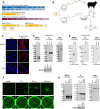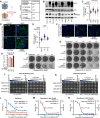A plasmid DNA-launched SARS-CoV-2 reverse genetics system and coronavirus toolkit for COVID-19 research
- PMID: 33630831
- PMCID: PMC7906417
- DOI: 10.1371/journal.pbio.3001091
A plasmid DNA-launched SARS-CoV-2 reverse genetics system and coronavirus toolkit for COVID-19 research
Abstract
The recent emergence of Severe Acute Respiratory Syndrome Coronavirus 2 (SARS-CoV-2), the underlying cause of Coronavirus Disease 2019 (COVID-19), has led to a worldwide pandemic causing substantial morbidity, mortality, and economic devastation. In response, many laboratories have redirected attention to SARS-CoV-2, meaning there is an urgent need for tools that can be used in laboratories unaccustomed to working with coronaviruses. Here we report a range of tools for SARS-CoV-2 research. First, we describe a facile single plasmid SARS-CoV-2 reverse genetics system that is simple to genetically manipulate and can be used to rescue infectious virus through transient transfection (without in vitro transcription or additional expression plasmids). The rescue system is accompanied by our panel of SARS-CoV-2 antibodies (against nearly every viral protein), SARS-CoV-2 clinical isolates, and SARS-CoV-2 permissive cell lines, which are all openly available to the scientific community. Using these tools, we demonstrate here that the controversial ORF10 protein is expressed in infected cells. Furthermore, we show that the promising repurposed antiviral activity of apilimod is dependent on TMPRSS2 expression. Altogether, our SARS-CoV-2 toolkit, which can be directly accessed via our website at https://mrcppu-covid.bio/, constitutes a resource with considerable potential to advance COVID-19 vaccine design, drug testing, and discovery science.
Conflict of interest statement
The authors have declared that no competing interests exist.
Figures






References
-
- Wang H, Zhang Y, Huang B, Deng W, Quan Y, Wang W, et al.. Development of an inactivated vaccine candidate, BBIBP-CorV, with potent protection against SARS-CoV-2. Cell [Internet]. 2020. June 6 [cited 2020 Jun 8];0(0). Available from: https://www.cell.com/cell/abstract/S0092-8674(20)30695-4. - PMC - PubMed
-
- WHO Coronavirus Disease (COVID-19) Dashboard [Internet]. [cited 2020 Aug 23]. Available from: https://covid19.who.int.
-
- Petersen E, Koopmans M, Go U, Hamer DH, Petrosillo N, Castelli F, et al.. Comparing SARS-CoV-2 with SARS-CoV and influenza pandemics. The Lancet Infectious Diseases [Internet]. 2020. July 3 [cited 2020 Aug 20];0(0). Available from: https://www.thelancet.com/journals/laninf/article/PIIS1473-3099(20)30484.... 10.1016/S1473-3099(20)30484-9 - DOI - PMC - PubMed
Publication types
MeSH terms
Substances
Grants and funding
- MC_UU_12014/8/MRC_/Medical Research Council/United Kingdom
- MC_PC_20034/MRC_/Medical Research Council/United Kingdom
- MR/V03541X/1/MRC_/Medical Research Council/United Kingdom
- MR/T029188/1/MRC_/Medical Research Council/United Kingdom
- MC_UU_12014/12/MRC_/Medical Research Council/United Kingdom
- MC_UU_12014/10/MRC_/Medical Research Council/United Kingdom
- MR/P022642/1/MRC_/Medical Research Council/United Kingdom
- MC_UU_12014/2/MRC_/Medical Research Council/United Kingdom
- 201366/Z/16/Z/WT_/Wellcome Trust/United Kingdom
- MC_PC_19026/MRC_/Medical Research Council/United Kingdom
- MR/K024752/1/MRC_/Medical Research Council/United Kingdom
- MC_UU_00018/1/MRC_/Medical Research Council/United Kingdom
LinkOut - more resources
Full Text Sources
Other Literature Sources
Medical
Molecular Biology Databases
Research Materials
Miscellaneous

